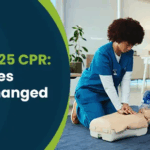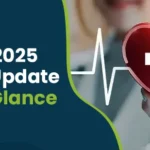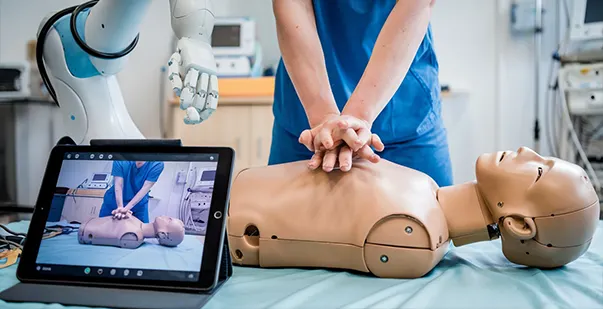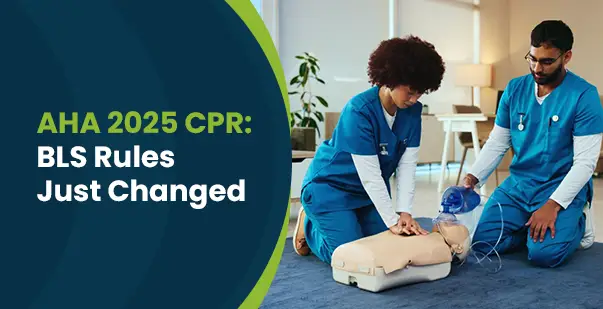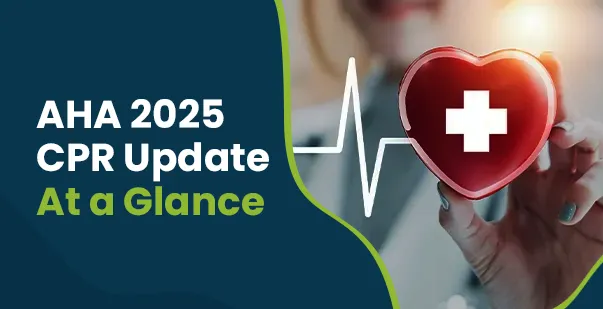What if technology could teach you how to save a life? With Artificial Intelligence in CPR, that’s not just a possibility. It has now become a reality. AI is transforming how we learn and perform first aid, especially critical techniques like CPR. AI is already assisting doctors in hospitals, analyzing patient data, and improving emergency response times. Soon, it will be part of your emergency toolkit, guiding you through CPR in real-time. AI-powered voice assistants, smart mannequins, and interactive training apps are making it easier for anyone to learn lifesaving techniques with confidence.
Gone are the days when CPR training meant simply practicing on a static mannequin. Today, AI-enhanced first aid training offers an immersive, interactive experience that adapts to each learner’s progress. Read on to find out how AI is impacting healthcare, especially the way CPR and first aid are provided.
What is Artificial Intelligence?
Artificial Intelligence (AI) is defined as a machine’s ability to learn, think, and act like humans. They solve problems, understand speech, and even make decisions. AI operates through machine learning algorithms, deep learning, and natural language processing. AI tries to think like a human by looking at lots of information and finding patterns, just like how you might remember where you left your favorite toy by noticing where you’ve seen it before. It learns through machine learning and deep learning, using huge amounts of data to recognize mistakes, improve accuracy, and make smart predictions.
AI is becoming a powerful tool in healthcare. It helps doctors diagnose diseases faster and more accurately. AI systems can study thousands of medical cases to predict illnesses before they happen. They also create personalized treatment plans for patients. Moreover, AI is now entering emergency care. Developers and healthcare professionals are working together to build devices that can guide you through CPR in real-time or an app that trains you to handle emergencies.
How is AI Changing CPR Training?
Many people feel nervous about learning CPR, but AI-powered tools make training more engaging and less intimidating. Smart mannequins, virtual instructors, and real-time feedback systems help learners practice effectively and build confidence before an actual emergency. AI-powered CPR training is transforming how people learn, making it more accessible, personalized, and effective. Hence, everyone can learn CPR techniques easily, helping to keep the community safer and better prepared for emergencies. Following are the key areas where AI has significantly impacted CPR training:
Real-time Feedback in CPR Training
Real-time feedback from AI in CPR and first aid enhances overall learning through accuracy and technique improvement. The systems are able to identify errors and immediately correct them for the trainees to hone their skills.
AI-Powered Sensors
Training mannequins, like the Brayden CPR manikin or the Resusci Anne QCPR, are equipped with sensors that monitor compression depth, rate, and timing. AI analyzes this data to detect errors, such as shallow compressions or inconsistent rhythm. Feedback is provided through auditory or visual cues, which enable trainees to adjust their technique on the spot.
Immediate Corrections
AI systems alert learners if their compressions deviate from the ideal. For example, if compressions are too slow, the system signals the learner to speed up. This instant feedback is important because it helps build muscle memory and confidence, ensuring that learners can perform CPR correctly in real-life emergencies. Many CPR simulators, including Laerdal’s QCPR series, use AI to guide learners in real-time. For instance, if compressions are too slow, the system beeps faster to signal the correct pace. If the pressure is too weak, an LED light system changes color to indicate the need for deeper compressions.
AI-Driven Mobile Applications
Many apps connect to smart mannequins via Bluetooth, displaying real-time feedback on compression rate, recoil, and ventilation volume. This allows learners to track their progress and improve their skills with data-driven insights.
Personalization in CPR Training
AI has changed how people learn CPR by making lessons fit each person’s needs. Instead of the same training for everyone, AI adjusts to your progress, skills, and learning style. This way, every learner gets what they need to improve. AI features in many software and applications act as a personal coach that guides you step by step. The main approaches to this personalization include:
Adapting to Learner Progress
Consider you are learning CPR, but your chest compressions are too shallow. Instead of moving on, AI notices this and gives you more practice on compression depth. For example, it might say, “Press a bit deeper, like this,” and show you an animation. With this guidance, you fix mistakes immediately and feel more confident about getting it right in real emergencies.
Custom Training Modules
If you are just starting out, AI keeps things simple, teaching you basic compressions and guiding you through the rhythm. But if you are more advanced, it ramps things up. The AI creates a tougher challenge, like a noisy, crowded scene with multiple victims needing CPR. It adjusts the training to fit your level, keeping beginners from feeling overwhelmed and giving advanced learners the practice they need for complex situations.
Self Paced Learning
Not everyone learns CPR at the same speed. AI adapts training to each person’s progress, which offers extra guidance when needed. Some learners might struggle with hand positioning, while others need help with compression timing. AI-powered programs adjust difficulty levels and provide personalized coaching, which allows users to practice at their own pace until they master the skill.
Also Read: History Of CPR: When Was CPR Invented?
Can AI Voice Assistants Effectively Teach CPR?
Voice assistants like Alexa are super helpful when you’re looking for info, but they don’t always get CPR instructions right. Some of the important points to consider are as follows:
Accessibility and Ease of Use
AI tools are available on millions of devices worldwide, making CPR instructions accessible to many people, whether at home, work or in public places. Their simple voice-activated design means even someone with no medical training can ask for help. For instance, you could say, “Alexa, how do I perform chest compressions?” and get instant guidance. However, although AI tools make CPR instructions more accessible, that doesn’t always mean they are reliable.
Limitations of Current Systems
A Harvard-led study found serious gaps in how AI voice assistants provide CPR instructions. Researchers asked common CPR-related questions to assistants like Siri, Alexa, and Google Assistant, as well as ChatGPT. The results were surprising:
- Only 34% of the responses from voice assistants included CPR instructions.
- Nearly 50% of responses were irrelevant, like mentioning a movie titled CPR or providing unrelated news links.
- Just 28% of the responses suggested calling emergency services.
This lack of accuracy can cost precious time during emergencies, especially for something as critical as CPR. The study also noted that ChatGPT performed better than voice assistants, but even it wasn’t perfect.
How Virtual Reality and AI are Changing CPR Training?
Virtual Reality (VR) and Artificial Intelligence (AI) are changing the way CPR training is conducted. It now mimics real-life situations and makes the training very realistic. The tools simulate emergencies in such a way that learners can practice techniques in a safe, controlled, and interactive environment. Virtual reality can make you feel like you are really in a park trying to help someone, and the AI will correct your technique if you are not pressing hard enough. Combining hands-on practice with advanced technology, VR, and AI better prepares trainees to handle high-pressure situations.
Simulation of Real-Life Emergencies
AI-powered VR systems can create many different situations, such as practicing CPR on a virtual person who suddenly falls in a crowded park or at a concert. The system can include sounds from the background, people watching, or even a countdown timer to imitate the pressure of real emergencies.
These simulations change based on how well you perform the necessary steps. If you have trouble with the depth or timing of chest compressions, the AI will focus on those parts. This helps you improve your skills in a way that seems real.
Realistic Learning Experience
Virtual reality headsets allow you to interact with virtual patients in 3D environments. No longer will you sit there just watching videos or working on CPR manikins; instead, you are put into an entirely immersive world in which you respond to emergencies.
For example, if you are doing CPR on a virtual patient, the AI gives you quick feedback, like “Push harder”, “Slow down” or “Check for breathing again”. This practical method not only helps you get better at the skills but also boosts your confidence and helps you feel ready to deal with stressful situations.
Personalized Training Programs
AI-driven systems can tailor CPR training based on your performance and skill level. For instance, if you are a beginner, the program starts with simple techniques. The more you advance, the more complicated the situations will be, like dealing with several victims or administering CPR in extreme conditions.
This personalized approach to training keeps the training engaging while ensuring you develop your skills at a comfortable pace and overcome your weaknesses.
Making Practice Relevant to Real-Life Situations
Traditional CPR training often seems irrelevant to the real emergency. You practice on a dummy in a calm room and cannot prepare yourself for the chaos of a real situation. VR and AI help in this by creating stressful situations where you have to act fast and with confidence.
For instance, you may simulate performing CPR on a pretend patient with the sounds of sirens of an ambulance, crying people, or ringing phones. This type of training will keep you calm and focused when it really matters.
Also Read: Learn What Does CPR Stand For And Why Is It Important
How AI Helps Enhance Access to CPR Training
Smart CPR technology is breaking down barriers in education by making training widely accessible. With innovative tools, people worldwide can learn life-saving skills efficiently. AI-driven tools provide flexible learning options, multilingual support, and real-time guidance, ensuring more individuals are prepared to respond in emergencies.
Remote Learning
Online CPR training powered by AI allows individuals to learn anytime, anywhere. These platforms eliminate the need for in-person sessions, making CPR education more flexible and widely available. Interactive simulations and real-time feedback help learners practice techniques effectively, ensuring they gain the confidence and skills needed to perform CPR in real-life situations.
Training in Other Languages and Cultures
AI-driven CPR training programs offer multilingual support, making life-saving education accessible to people from diverse backgrounds. These platforms adapt content to different cultures and communication styles, helping non-native speakers understand CPR techniques clearly. This inclusivity ensures that more individuals worldwide can act confidently with AI in medical emergencies to increase survival rates in their communities.
Keeping CPR Skills Fresh
AI-powered apps don’t just teach CPR; they help you retain your skills over time. For example, an AI system might send reminders like:
- “It’s been three months since your last CPR practice, time for a refresher!”
- “Would you like to test your skills today?”
These gentle reminders ensure learners don’t forget their training, keeping them prepared to act in real emergencies.
What Could AI Do for CPR Training in the Future?
Emerging innovations in AI-powered healthcare solutions, such as AI-assisted telemedicine and drone technology, are changing how rescuers provide emergency response. Future advancements may provide real-time CPR guidance, deliver medical equipment faster, and enhance global access to life-saving interventions. These developments could significantly improve survival rates by ensuring swift, efficient assistance during critical moments.
AI-Assisted Telemedicine
Telemedicine platforms powered by AI can connect bystanders with medical professionals in real-time during emergencies. AI can guide individuals through CPR steps while ensuring proper technique by analyzing video or audio input. This immediate expert support increases the chances of effective resuscitation, especially in situations where professional help is delayed.
AI-Powered CPR Drones
Drones equipped with AI technology can rapidly deliver automated external defibrillators (AEDs) to remote or high-traffic areas where medical help may be delayed. These drones can also provide step-by-step audio instructions for performing CPR. These drones can reduce response time and save countless lives, particularly in cases of sudden cardiac arrest.
| Fun Prediction: In the future, your AI CPR coach might be with you at all times. Imagine rushing to help someone in distress, and your smartwatch or AI assistant guides you in real-time:“Stay calm. Check for breathing.”“Start chest compressions now. I’ll count with you.”“An ambulance is on the way. Keep going, you are doing great.”With AI constantly evolving, the future of CPR training looks smarter, faster, and more accessible than ever so that more lives are saved, one innovation at a time. |
Use AI For Advanced CPR Care!
Artificial Intelligence is making CPR training more effective, accessible, and engaging. AI-powered simulations provide real-time feedback. Virtual training platforms remove the barriers of traditional in-person classes, allowing anyone to practice CPR anytime. AI-driven programs also adapt to individual learning styles so that each participant gains confidence in performing life-saving techniques.
Beyond training, artificial intelligence improves outcomes in emergency response by guiding bystanders during real-life situations. Smart assistants and telemedicine platforms can offer step-by-step CPR instructions, while AI-powered drones deliver automated external defibrillators (AEDs) to critical locations. Now is the perfect time to equip yourself with essential life-saving skills. Enroll in an AI-powered CPR course today, and be prepared to act confidently in an emergency.
FAQs
- How is artificial intelligence used in cardiology?
AI in cardiology enhances diagnostics, predicts heart diseases, and assists in treatment planning. Machine learning algorithms analyze ECGs, echocardiograms, and cardiac MRIs to detect abnormalities. AI also helps in risk assessment for conditions like atrial fibrillation and heart failure, improving patient outcomes through early intervention and precision medicine.
- What is artificial CPR?
Artificial CPR refers to the use of automated systems, such as mechanical chest compression devices and AI-driven monitoring, to perform or assist in cardiopulmonary resuscitation. These systems ensure consistent compression depth and rate, reducing rescuer fatigue. AI also aids in optimizing CPR by analyzing real-time patient data and adjusting compressions accordingly.
- What is the role of artificial intelligence in firefighting?
AI improves firefighting by predicting fire spread, enhancing situational awareness, and optimizing resource allocation. Drones with AI-powered thermal imaging detect hotspots, while machine learning analyzes weather and environmental data for risk assessment. AI-driven robots can assist in hazardous environments, reducing firefighter exposure to life-threatening conditions and improving emergency response efficiency.
- What training materials will be used to teach CPR and artificial respiration?
Training includes manikins with feedback systems, video-based instruction, online simulations, and hands-on practice guided by certified instructors. Advanced courses incorporate AI-powered virtual trainers and augmented reality simulations for real-time guidance. Automated external defibrillator (AED) training devices also help learners practice life-saving techniques effectively in various emergency scenarios.
